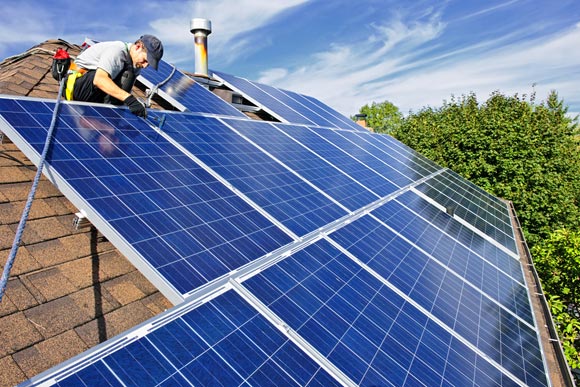Solar panels are mounted on areas with maximum sunlight exposure. Different shapes of area act as crucial factors especially when the panels are put up on the roof. Usually house roofs have maximum sunlight throughout the day and henceforth many people prefer installing solar panels on roofs. The efficiency of the solar panels and the magnitude of their output largely depend upon the sunlight that is incident upon them and in what angular direction. The principal factors that affect the operation of the solar panels are the nature of their mounting and exposure to the sun. Rooftop is by far the best choice if one is willing to install solar panels as roof has ample of sunlight throughout the day. Proper orientation of the panels on the roof is essential. There are various options provided when it comes to mounting of the solar panels. The rooftop can be flat, tilted, pitched and so on and the method of mounting and efficiency varies too. Here is a description of roofing types most suited for the installation of solar panels.

Basic requirements
The roofs need to be free of shades. The roof must be featured with enough open space, with full exposure to sunlight essentially south facing, and tilted at an angle of approximately forty degrees for maximum output of the solar panels. If the roof of one’s house suits none of these criteria, it becomes tough but not impossible to install solar panels upon it. The posts, wedges and other such components are there to serve the purpose of anchorage and tilt to the panels for satisfactory exposure to sunlight.
Installation
In case one has plans to install solar panels on the roof then flat roof is the best. Moreover, the installation process is the easiest. Flat roof provides wide angle of rotation of the panels and allows unhindered tilting of each of the panels depending upon the direction of the sunlight. This degree of freedom of movement helps to yield maximum power output. People prefer this installation in business sectors as the process is easy and uncomplicated. This flat roof top installation of solar panels indulges the installers to follow different methods of mounting.
Hybrid mounting
This includes some of the procedural steps of the ballasted architecture. The solar panels are closely placed so that maximum sunlight is incident on the panels. The ballasted attachment makes use of ballasts rise the solar panels instead of letting them remain flat on the surface. This angular set up allows better exposure to sunlight. This mounting is only possible when the available roof area is large. This installation is preferred by most especially in the industrial domain because the panels are arranged in such a way so that penetration into the roof is totally avoided. The system is highly efficient especially in area falling under the low wind zone.
Mechanical mount
In this, posts are to be mounted on the roof. Once the posts are secured, the solar panels can be mounted on posts in specific directions or angles. This method is free of leakage and is suitable for both large and small areas. The posts help to hold the panels tightly and hence it does not require a non-windy area for its efficient performance. It can work well in high wind zones.
Wedges
One can also install the solar panels wither on the roof or any open area with the help of steel wedges that helps to keep the panels up and gives proper anchorage to the panels. This method is usually undertaken when the building is blocked by another higher building, so the sunlight misses the roof. Then these structures are mounted and the panels are anchored to let the sunlight be incident on them.
Angled or tilted roof installation
In this installation process, the roof is pitched or tilted in an angle. This is the most common type of installation process. Usually the roofs are angled instead of being flat and in such cases, the panels are installed and anchored with enormous difficulty. Flat roof has disadvantages too even if the process is not complicated. Flat roof installation requires a minor angular tilt, and with time, its performance diminishes as dust and debris collects all over its surface.
Conclusion
Roof shape even though is an important factor is not a prime factor for proper working of the solar panels. Adequate processes are there that can be adopted to make the solar panels work efficiently even though the roof shape is not favorable.




